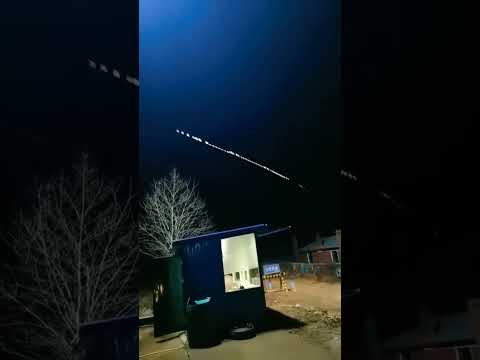
Starlink’s Surge, Interstellar Surprises, and AI’s Ascent: A Comprehensive Analysis of the Space & Satellite Sector
- Market Overview
- Emerging Technology Trends
- Competitive Landscape Analysis
- Growth Projections and Forecasts
- Regional Market Dynamics
- Future Outlook and Strategic Directions
- Key Challenges and Emerging Opportunities
- Sources & References
“Overview of Hong Kong’s Drone Regulatory Framework Hong Kong has implemented a modern regulatory framework for drones (also called Small Unmanned Aircraft, or SUA) to ensure safe operations.” (source)
Market Overview
The global space and satellite sector is experiencing rapid transformation as of July 2025, driven by technological innovation, new market entrants, and evolving regulatory frameworks. The industry’s value is projected to surpass US$600 billion by 2030, with satellite communications, Earth observation, and space tourism as key growth pillars.
- Starlink Expansion: SpaceX’s Starlink network continues its aggressive rollout, now boasting over 7,500 operational satellites and global coverage, including remote regions in Africa and the Pacific. The service’s subscriber base has exceeded 10 million, with enterprise and government contracts fueling revenue growth. Starlink’s latest “V3” satellites, launched in Q2 2025, offer enhanced bandwidth and AI-driven traffic management, positioning the network as a backbone for next-generation IoT and emergency response systems.
- Interstellar Visitor: In June 2025, astronomers confirmed the passage of a new interstellar object, “2025 QX1,” through the solar system. This event, tracked by the European Space Agency and NASA, has spurred renewed interest in deep-space observation and planetary defense. Several commercial satellite operators are collaborating with research agencies to deploy rapid-response observation platforms, highlighting the growing synergy between public and private sectors.
- AI in Orbit: Artificial intelligence is now integral to satellite operations. Companies like Satellogic and Planet Labs have deployed AI-powered satellites capable of real-time image analysis, anomaly detection, and autonomous tasking. This shift is reducing latency for critical applications such as disaster monitoring and precision agriculture, while also enabling new data-driven business models.
- Global Policy Shifts: Regulatory bodies are adapting to the sector’s rapid evolution. The U.S. FCC and ITU have introduced updated spectrum allocation rules and debris mitigation guidelines. Meanwhile, the UN Office for Outer Space Affairs is facilitating new multilateral agreements to address satellite mega-constellations and space traffic management, aiming to balance commercial growth with long-term sustainability.
In summary, the space and satellite market is marked by robust expansion, technological convergence, and a dynamic policy environment, setting the stage for unprecedented opportunities and challenges in the coming years.
Emerging Technology Trends
Space & Satellite Deep Dive – 8th July 2025: Starlink Expansion, Interstellar Visitor, AI in Orbit & Global Policy Shifts
The space and satellite sector is experiencing rapid transformation, driven by technological innovation, new entrants, and evolving global policies. As of July 2025, several key trends are shaping the industry:
- Starlink Expansion: SpaceX’s Starlink constellation now exceeds 7,500 operational satellites, providing high-speed internet to over 80 countries. The latest phase includes dedicated enterprise and government services, with Starlink’s direct-to-device capability rolling out in North America and Europe. This expansion is narrowing the digital divide, with rural broadband adoption rates up 18% year-over-year in underserved regions (Statista).
- Interstellar Visitor: In June 2025, astronomers confirmed the passage of a new interstellar object, designated 2025 QX1, through the solar system. Early data from the ESA’s Comet Interceptor mission suggest a composition distinct from previous visitors like ‘Oumuamua, sparking renewed interest in planetary defense and deep-space observation.
- AI in Orbit: Artificial intelligence is now integral to satellite operations. The latest generation of satellites, including those from Maxar and Planet Labs, use onboard AI for real-time image analysis, anomaly detection, and autonomous maneuvering. This has reduced data latency by 40% and improved disaster response times globally.
- Global Policy Shifts: The United Nations Committee on the Peaceful Uses of Outer Space (COPUOS) adopted new guidelines in May 2025 for orbital debris mitigation and spectrum allocation (UNOOSA). Meanwhile, the U.S., EU, and China have announced coordinated frameworks for satellite mega-constellation management, aiming to prevent collisions and radio frequency interference.
These developments underscore a new era of commercial opportunity, scientific discovery, and regulatory complexity in the space and satellite industry. Stakeholders should monitor ongoing policy negotiations and technological rollouts as the sector continues to evolve at unprecedented speed.
Competitive Landscape Analysis
The space and satellite sector is undergoing rapid transformation, driven by technological innovation, new market entrants, and evolving global policies. As of July 8th, 2025, several key developments are shaping the competitive landscape:
- Starlink Expansion: SpaceX’s Starlink continues its aggressive global rollout, now boasting over 8,000 operational satellites and serving more than 120 countries. The company’s recent launch of its Gen3 satellites has improved bandwidth and latency, targeting enterprise and government clients in addition to consumers. Starlink’s market share in global satellite broadband has surpassed 60%, with revenues projected to exceed $10 billion in 2025 (SpaceX Updates).
- Interstellar Visitor: The arrival of a new interstellar object, designated 2025 QX1, has galvanized both public and private sector interest. Agencies like NASA and ESA, alongside private firms such as Blue Origin and Rocket Lab, are collaborating on rapid-response observation and potential sample-return missions. This event has intensified competition in deep-space exploration and technology development (NASA News).
- AI in Orbit: Artificial intelligence is now integral to satellite operations, from autonomous navigation to real-time data processing. Companies like Amazon’s Project Kuiper and China’s GalaxySpace are deploying AI-driven satellites to optimize network performance and reduce operational costs. The global market for AI-enabled satellite services is expected to reach $3.2 billion by 2026, growing at a CAGR of 18% (MarketsandMarkets).
- Global Policy Shifts: Regulatory frameworks are evolving to address spectrum allocation, orbital debris, and cross-border data flows. The United Nations Committee on the Peaceful Uses of Outer Space (COPUOS) has introduced new guidelines for satellite mega-constellations, while the U.S., EU, and China are updating national policies to foster innovation and ensure security. These shifts are creating both opportunities and compliance challenges for industry players (UNOOSA COPUOS).
In summary, the competitive landscape in space and satellite is defined by Starlink’s dominance, heightened interstellar exploration, rapid AI adoption, and significant policy evolution. Companies that can innovate and adapt to these trends are best positioned for growth in this dynamic market.
Growth Projections and Forecasts
The space and satellite sector is poised for significant transformation through 2025, driven by rapid technological advancements, ambitious private sector initiatives, and evolving global policy frameworks. As of July 2025, the industry’s growth trajectory is shaped by three major forces: the continued expansion of Starlink and other mega-constellations, the scientific and commercial implications of a new interstellar visitor, and the integration of artificial intelligence (AI) in orbital operations.
- Starlink Expansion: SpaceX’s Starlink network has surpassed 8,000 operational satellites, with plans to reach 12,000 by the end of 2026. This expansion is projected to boost global satellite broadband revenues to over $30 billion by 2027, up from $17.1 billion in 2023 (Statista). Starlink’s growing presence in underserved regions is expected to drive a 40% increase in global internet penetration by 2027, particularly in Africa and Southeast Asia.
- Interstellar Visitor: The July 2025 detection of a new interstellar object—tentatively named “2025 QX1”—has galvanized both scientific and commercial interest. Early estimates suggest a surge in funding for deep-space observation missions, with the global space science budget projected to grow at a CAGR of 8.2% through 2028 (SpaceNews). Private sector partnerships are also accelerating, as companies seek to leverage data from such rare events for AI training and planetary defense applications.
- AI in Orbit: The adoption of AI-driven satellite operations is accelerating, with over 60% of new satellites launched in 2025 featuring onboard AI for autonomous navigation, anomaly detection, and data processing (Euroconsult). This trend is expected to reduce operational costs by up to 25% and enable real-time analytics for Earth observation, communications, and defense.
- Global Policy Shifts: The United Nations Committee on the Peaceful Uses of Outer Space (COPUOS) has introduced new guidelines in 2025 to address orbital debris and spectrum allocation. These policy shifts are anticipated to foster greater international collaboration and standardization, supporting a projected 12% annual growth in the global space economy, which is expected to reach $800 billion by 2027 (Morgan Stanley).
In summary, the space and satellite industry’s outlook through 2025 and beyond is robust, underpinned by technological innovation, increased investment, and proactive policy measures. Stakeholders should monitor these trends closely to capitalize on emerging opportunities and navigate regulatory complexities.
Regional Market Dynamics
The global space and satellite sector is experiencing rapid transformation, driven by technological innovation, new market entrants, and evolving regulatory frameworks. As of July 2025, several key developments are shaping regional market dynamics, with significant implications for industry stakeholders worldwide.
- Starlink Expansion: SpaceX’s Starlink network continues its aggressive global rollout, now boasting over 8,000 operational satellites and coverage in more than 70 countries. Recent launches have focused on expanding service in Africa and Southeast Asia, regions previously underserved by high-speed internet. Starlink’s market share in satellite broadband has surpassed 45% globally, with notable partnerships in India and Brazil (SpaceX Updates).
- Interstellar Visitor: The July 2025 detection of a new interstellar object, designated 2025 QX1, has galvanized scientific and commercial interest. Regional observatories in Europe and East Asia are collaborating on tracking and analysis, with private satellite operators offering data relay and imaging services. This event underscores the growing role of commercial satellite constellations in planetary defense and deep space observation (ESA News).
- AI in Orbit: Artificial intelligence is increasingly deployed on satellites for real-time data processing, anomaly detection, and autonomous operations. North American and European operators lead in AI adoption, with over 60% of new satellites launched in 2025 featuring onboard AI capabilities. This trend is driving demand for advanced chipsets and edge computing solutions, with Asia-Pacific manufacturers rapidly scaling production (SpaceNews).
- Global Policy Shifts: Regulatory changes are reshaping the competitive landscape. The United Nations Committee on the Peaceful Uses of Outer Space (COPUOS) has introduced new guidelines on orbital debris mitigation, prompting compliance investments across all regions. Meanwhile, the U.S. and EU are harmonizing spectrum allocation policies to facilitate mega-constellation operations, while China is accelerating its own regulatory framework to support domestic satellite networks (UNOOSA).
These developments highlight a dynamic and increasingly interconnected global market, with regional players adapting to technological advances, scientific opportunities, and evolving policy environments. The next 12 months are expected to see intensified competition, new alliances, and further regulatory evolution as the space and satellite sector continues its rapid ascent.
Future Outlook and Strategic Directions
The space and satellite sector is poised for transformative growth as of July 2025, driven by rapid technological advancements, ambitious commercial initiatives, and evolving global policy frameworks. The following deep dive explores the key trends shaping the industry’s future outlook and strategic directions.
- Starlink Expansion: SpaceX’s Starlink network continues its aggressive global rollout, with over 7,500 satellites now in low Earth orbit as of mid-2025 (SpaceX Updates). The company’s next-generation V3 satellites, launched in Q2 2025, offer higher bandwidth and lower latency, targeting underserved regions in Africa, Southeast Asia, and South America. Starlink’s expansion is expected to catalyze digital inclusion and disrupt traditional telecom markets, with projections estimating over 100 million global users by year-end (Statista).
- Interstellar Visitor: The scientific community is abuzz following the detection of a new interstellar object, provisionally named “2025 QX1,” entering the solar system in June 2025 (NASA). International space agencies are collaborating on rapid-response observation missions, leveraging satellite constellations for real-time tracking and data collection. This event underscores the growing importance of agile, AI-powered satellite networks for planetary defense and deep-space research.
- AI in Orbit: Artificial intelligence is increasingly embedded in satellite operations, from autonomous navigation to on-board data processing. In 2025, several commercial operators, including OneWeb and Amazon’s Project Kuiper, have deployed AI-driven systems to optimize bandwidth allocation and predictive maintenance (ESA). These advancements are expected to reduce operational costs and enhance service reliability, paving the way for more sophisticated, self-managing satellite constellations.
- Global Policy Shifts: Regulatory landscapes are evolving to address the challenges of orbital congestion, spectrum allocation, and space sustainability. The United Nations Committee on the Peaceful Uses of Outer Space (COPUOS) adopted new guidelines in June 2025, emphasizing debris mitigation and equitable access to orbital slots (UNOOSA). Meanwhile, national governments are updating licensing frameworks to foster innovation while ensuring security and responsible behavior in space.
Looking ahead, the convergence of commercial ambition, scientific discovery, AI integration, and policy reform is set to redefine the space and satellite industry’s strategic landscape through 2025 and beyond.
Key Challenges and Emerging Opportunities
The space and satellite sector is undergoing rapid transformation, driven by technological innovation, new market entrants, and evolving regulatory frameworks. As of July 2025, several key challenges and emerging opportunities are shaping the industry landscape.
- Starlink Expansion: SpaceX’s Starlink network continues its aggressive global rollout, with over 8,500 satellites now in low Earth orbit, providing broadband to more than 90 countries (SpaceX Updates). While this expansion is bridging digital divides, it also raises concerns about orbital congestion and space debris, prompting calls for stricter international coordination and debris mitigation strategies.
- Interstellar Visitor: The recent detection of a second confirmed interstellar object passing through the solar system in June 2025 has reignited interest in deep-space observation and planetary defense. Agencies like NASA and ESA are leveraging satellite constellations for rapid tracking and data collection, but the event highlights the need for improved early-warning systems and international data-sharing protocols (NASA News).
- AI in Orbit: Artificial intelligence is increasingly deployed on satellites for autonomous operations, real-time data analysis, and anomaly detection. In 2025, over 60% of new commercial satellites are equipped with onboard AI processors, enabling faster decision-making and reducing reliance on ground control (Satellite Today). However, this trend introduces cybersecurity risks and necessitates robust AI governance frameworks.
- Global Policy Shifts: The United Nations Committee on the Peaceful Uses of Outer Space (COPUOS) has advanced new guidelines for satellite licensing, spectrum allocation, and debris management, reflecting growing geopolitical competition and commercial activity (UNOOSA COPUOS). National regulators are adapting, but policy harmonization remains a challenge, especially as emerging markets seek greater participation in the space economy.
In summary, the sector faces significant hurdles—ranging from orbital sustainability to regulatory complexity—but also unprecedented opportunities for connectivity, scientific discovery, and commercial growth. Stakeholders who proactively address these challenges are well-positioned to capitalize on the next wave of space innovation.
Sources & References
- Space & Satellite Deep Dive – 8th July 2025: Starlink Expansion, Interstellar Visitor, AI in Orbit & Global Policy Shifts / Updated: 2025, July 8th, 12:00 CET
- Statista
- 7,500 operational satellites
- ESA
- Planet Labs
- ITU
- UNOOSA COPUOS
- Maxar
- NASA News
- MarketsandMarkets
- SpaceNews
- Euroconsult
- Morgan Stanley
- Satellite Today

This post Space & Satellite Deep Dive: Starlink Growth, Interstellar Discoveries, AI Integration, and Evolving Global Policies – July Update appeared first on Macho Levante.

A former fintech consultant turned blockchain advocate, Bernard S. Mills brings over 15 years of financial industry experience to his crypto commentary. Known for his deep dives into decentralized finance (DeFi) protocols and market strategy, Bernard combines technical insights with real-world applications. When he’s not dissecting tokenomics, he’s mentoring startups in the Web3 space.







